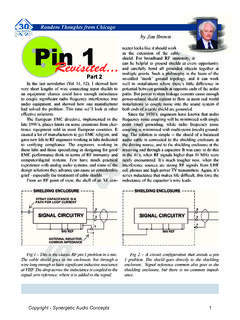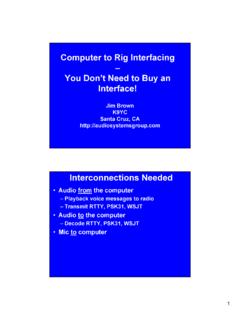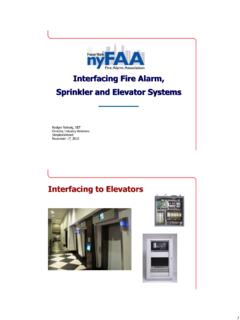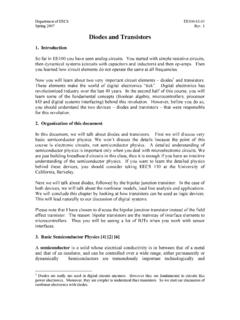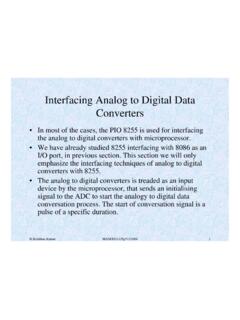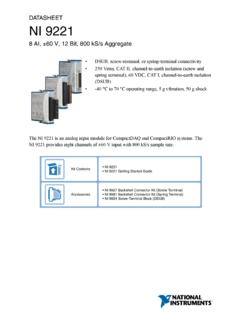Transcription of A Ham's Guide to RFI, Ferrites, Baluns, and Audio ...
1 A Ham's Guide to RFI, ferrites , Baluns, and Audio interfacing Revision 7 Jan 2019. by Jim Brown K9YC. The basis of this tutorial is a combination of my engineering education, 60 years in ham radio, my work as vice-chair of the AES Standards Committee working group on EMC, and extensive re- search on RFI in the pro Audio world where I made my living. That work is documented in techni- cal papers and tutorials that can be downloaded from the publications section of my website. For this latest revision, much of the material on common mode chokes for transmitting has been moved to a new applications note. Chapter 1 Some Fundamentals To solve interference problems, we must understand them. So we'll begin by describing the ways that RF interference is coupled into equipment and detected. There are several principal mecha- nisms at work. You should study this tutorial thoroughly to understand how these things work. Detection at Semiconductor Junctions Every semiconductor junction, whether part of a diode, transistor, or integrated circuit, is quite nonlinear, especially in the voltage region where it is begin- ning to conduct.
2 In analog circuits, we prevent this non-linearity from causing distortion by prop- erly biasing the circuitry, by using lots of negative feedback, and by preventing the signal from be - ing large enough to cross into the cutoff region. Thanks to this non-linearity, every semiconductor junction functions as a square law detector, de- tecting any RF signal it sees. A good designer prevents detection by shielding the equipment and its wiring, by filtering input and output wiring, and even by bypassing the junction by a capacitor. Since virtually all detection that causes RFI follows square law, the strength of the signal detected by Audio equipment, telephones, and other equipment will increase (or decrease) as the square of any increase (or decrease) in RF level at the detector. In other words, the strength of the detected RF changes by twice the number of dB that the RF signal changes. This means that if we manage to reduce the interfering RF signal by 6 dB, the detected Audio will drop by 12 dB.
3 This is a very use - ful thing it means that we may not need "an elephant gun" to solve many interference problems. Antenna Action The most fundamental cause of radio interference to other systems is the fact that the wiring for those systems, both inside and outside the box, are antennas. We may call them "patch cables" or "speaker cables" or "video cables" or "Ethernet cables," or printed circuit traces, but Mother Nature knows that they are antennas! And Mother Nature always wins the argument. When we transmit, some of the RF from our transmitter is picked up by those unintentional anten- nas, and RF current flows on them. What happens to that current determines whether there will be interference, and how severe it will be. We know that antennas work in both directions that is, they follow the principle of reciprocity so when RF trash from inside the box flows on those an- tennas, it is radiated as noise and we hear it on the ham bands. Fig 1 shows a simple antenna we've all used, probably with our first radio receiver.
4 We con- nected a random wire to our receiver, and the antenna current flowed through the receiver to a "ground" that might have been a driven rod, but was more likely the safety ground of the AC. power line (the third pin on the AC socket, known in North America as the "green wire"). Even if the radio was double insulated so that it didn't require the green wire connection, RF. current still flowed through the stray capaci- tance of the power transformer to the power line and made the radio work. Fig 1 A simple random wire antenna RF picked up on the antennas we call loudspeaker wiring, video cables, the coax from the cable TV. system or a rooftop TV antenna, flows through equipment to get to the AC power system safety Entire Contents Copyright 2007-19 James W. Brown, except product data, which is copyright by Fair-Rite Products. All Rights Reserved Understanding and Solving RF Interference Problems Page 2. ground. Hams understand that some antennas are more effective than others.
5 An antenna that is close to resonance will work better than one that is not. Long antennas tend to pick up more RF. than short ones. Think about these fundamental principles when trying to diagnose which cables are bringing your RF into a given system (or radiating their trash into your receiving antenna). A path to "ground" or the power system is not always needed to produce antenna action. The whip antenna on our VHF and UHF handheld radios uses the radio, capacity-coupled to our hand that holds it, as a counterpoise (that is, to provide "the other half of the antenna"). All that is required for this to work is that the size of the counterpoise must be a significant fraction of a quarter wave (or larger) so that it can "sink" the antenna current. Common Mode and Differential Mode Signals A differential mode signal is one that exists be- tween the conductors of a cable. At any given point along the cable, current flowing on one con- ductor is precisely balanced by current flowing in the other direction on the other conductor.
6 The intentional signals carried by cables are differential mode signals the Audio or video signal in a home Audio system, Ethernet signals on CAT5/6 cable, and the RF signal carried by the feedline connecting our antennas to our transceivers. A common mode signal is one that places equal voltage on all conductors that is, the voltage be- tween the two ends of the cable are different, but there is no voltage between the conductors. An- tenna action produces a common mode voltage and current along a cable. The antenna current in- duced on Audio and video wiring is a common mode signal. That is, with "ideal" cable, there is no differential voltage between the signal conductors as a result of this antenna action. If the cable is shielded, nearly all of this current flows on the shield (and skin effect causes it to flow on the out- side of the shield). If the shield is ideal (that is, if the current is distributed with perfect uniformity around it), the field inside the shield will be zero, and thus none of this antenna current will flow inside the cable.
7 Conversely, when a cable shield is carrying differential mode current, as in the case of coax, skin effect will cause that differential mode current to flow on the inside of the shield. The real world is not ideal, so most interfering signals will simultaneously exist in both common mode and differential mode, but in most real world conditions, one or the other mode dominates. Several cable defects (essentially manufacturing tolerances) certainly can and do convert this "com- mon mode" antenna current to a differential signal (that is, a voltage between the signal conduc- tors), but that is rarely the most powerful coupling mechanism. One common defect that affects both balanced and unbalanced cables is imperfect construction of cable shields. In even the best "real world" balanced twisted pair cables, there are imbalances in the capacitance between "red". and "black" conductors to the shield on the order of 5%. [B. Whitlock, JAES, June 1995] In balanced paired cables that use "foil/drain" shields, there is even more imbalance in the inductive coupling between each conductor and the shield.
8 Noise (or RFI) coupled by this mechanism is called "shield-current-induced noise," or SCIN. [N. Muncy, JAES, June 1995] All three of these mecha- nisms convert shield current to a differential signal at system input and output terminals. Another imperfection in shielded cable is often quantified as its transfer impedance, which is de- fined as ratio of the differential voltage induced inside the cable to common mode current on the shield. Its units are Ohms, a low value is better, and the lower limit is the resistance of the shield at the frequency of interest. The overall quality, percent coverage, and uniformity of the shield also contribute to the transfer impedance a less dense braid or a shield with poor uniformity raise the transfer impedance, causing more noise to couple by this method. Mass-market cables sold to connect home entertainment systems often have very poor quality shields and high transfer impedance. The quality of shields of coaxial cables designed for radio systems varies widely.
9 Like most other things, you get what you pay for. If the cable is an unshielded pair (loudspeaker cable, for example), RF will be induced approxi- mately equally on both conductors (but, depending what the input circuit of the equipment looks like at RF, current flow into the equipment may not be equal on both conductors). This can also produce a differential voltage at the input (or output) terminals. Output Wiring is Important Too! It is well known, for example, that RF interference is often cou- pled into the output stage of Audio equipment for example, the power amplifiers that feed loud- Understanding and Solving RF Interference Problems Page 3. speakers or headphones. There is always feedback around that output stage, so RF present at the output will follow the feedback network to the input of a gain stage, where it will be detected and amplified. This problem is made much worse when parallel wire cable (zip cord) is used to feed the loudspeakers or headphones, and can usually be solved simply by replacing the zip cord with a twisted pair of POC (plain ordinary copper).
10 [Pseudo-scientific advertising hype for exotic cables notwithstanding, it was shown nearly 30 years ago that #12 copper twisted pair (or #10 for very long runs) is a nearly ideal loudspeaker cable.] [R. A. Greiner, "Amplifier Loudspeaker interfacing , . JAES Vol 28 Nr 5, May 1980] As we will discuss later, the twisting of a pair greatly reduces the level of RF that the wiring couples to circuitry. Power Supply and Control Wiring can also act as antennas. When I bought the house I owned in Chicago, I upgraded the electrical wiring and put all of it in steel conduit (EMT). This shielded the wiring, so that only the short power cords between equipment and the wall outlets could act as antennas. The house I recently bought in California is wired with no conduit, using unshielded parallel conductors. Thanks to its length, and the fact that it is not shielded, this wiring acts as an effective receiving antenna for the RF I am transmitting, and an effective transmitting antenna for the RF trash generated by computer equipment, power supplies for low voltage lighting fixtures, and even battery chargers.
